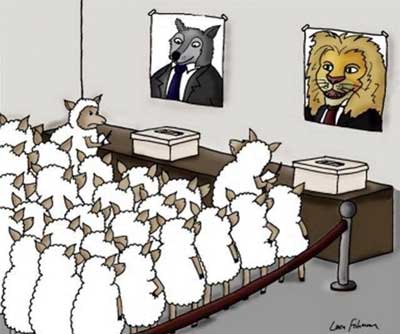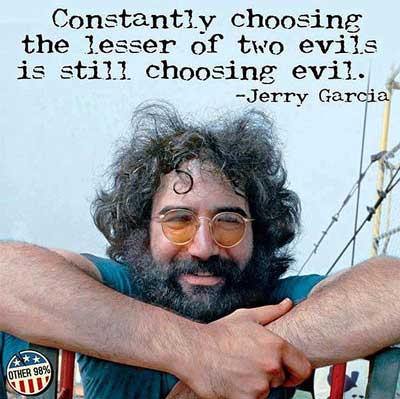
The third in a series of seven posts on Electoral Strategy for 2016
Each of the three components of the movement’s existing strategy accommodates triangulation in crucial ways.
Lesser of Two Evils
While the leading segments of the labor and social movements often employ all sorts of creative and inspiring tactics and campaigns and can master hard-knuckle negotiations with the boss, their electoral programs lack innovation or forceful negotiations. We act as if the New Deal coalition or the mid-century social contract is still with us, while both have been history since 1975 or so. [1]
The “lesser of two evil” voters in movement organizations are told by their lobbyists to “get in early.” Early support for Democrats is supposed to enhance the power of the movement organizations. Has this worked? While this might produce valuable results in local or state election, it has produced little on the national level.
Obamacare was the only important reform, but one a better use of our resources should have won many decades ago. President Truman called for national health care in 1945. After many millions of dollars spent and regular and extensive GOTV efforts we are over half a century without meaningful labor law or electoral reform.
 The “get-in early” approach of the lesser of two evils votes assures the Democrats that they do not have to work for our votes and deprives us of any real opportunity for hard bargaining. It turns our leaders into beggars. We are weak and humble before the strong when what we need, with so much at stake, is to be daring and bold.
The “get-in early” approach of the lesser of two evils votes assures the Democrats that they do not have to work for our votes and deprives us of any real opportunity for hard bargaining. It turns our leaders into beggars. We are weak and humble before the strong when what we need, with so much at stake, is to be daring and bold.
From the perspective of the inside/outside strategy, the lesser of two evils voters who desire real social change undermine their own power when they lash out at third parties or dissenters. Every pole of power — all the opposition — is necessary for us to make credible threats of exit. Threat of exit says, “Meet my expectations or I take my business elsewhere.” Triangulation insists there is no alternative for a reason: threat of exit amplifies our voice and power. If we have the courage to negotiate, then dissent and “voting with our feet” are indispensable resources. Unlock the exits.
Of all the many reasons that Gore lost the 2000 election, why were Nader and the Green Party singled out for all the shame and blame? And why has this bit of mythology passed so easily into “common sense” as we head into 2016? Triangulation compels surrender when there is no alternative.
And, it’s always easier to kick the dog than kick the master.
If our candidates do not offer compelling visions or persuasive programs, or invest in massive voter registration efforts, or defend themselves when elections are stolen, then the failure is ours. Blaming third party candidates for Republican victories — while distancing ourself from the non-voters — is a flimsy cover for our failure to organize and plays directly into triangulation.
With 70-90 million non-voters there is no spoiler — just our failure to contest power.
If we are interested in change we take risks — we unlock the exits and we organize. Setbacks and losses will occur in any event and already have. I think the history of the last 50 years is clear that the lesser of two evil voting has contributed more than its fair share to loss.
Fear of the right should not be an excuse for the simple-minded support of mainstream Democrats, since those Democrats have contributed in significant ways to the rise of the right.
We are stuck in a terrible dilemma but a vote for corporate, pro-war and drug war Democrats, to ward off the short-term attack from the extreme right, may well be winning the battle to lose the war. The human cost will be high in any event.
Think of the current trend lines of climate change, mass extinction, income inequality, racism, and war — just for starters. What are the risks involved in maintaining conventional political wisdom, given the likelihood that if we continue to act the same, the same situation will be reproduced? Where in the historical record is a single example of great changes occurring without great risks?
As the crisis deepens we will likely approach a shift in the equation of risk. The dangers we face to make the big changes will become less threatening than the dangers we face in continuing on the current course. Perhaps we are already there.
If I overstate my case it is because the lesser of two evils vote has, after all, been the most popular and well-funded approach and we should recognize its contribution both in terms of local and partial victories but also in its failure to produce significant social change. The lesser of two evils can occasionally win important concessions but never touch the core structures of power: the corporations, the war machine, mass communications and mass incarceration. And, we have to entertain the idea that the lesser of two evils shares responsibility for the rightward drift of American electoral politics.
Non-voters
Non-voters comply with one of the basic tenants of triangulation consistent with old style machine politics. Machines want only predictable and ”politically reliable” voters and prefer small voter turnouts. Triangulation prefers the 5% undecided centrists and writes off the non-voters as not worth the efforts or expense.
When progressives simply stay home the two-party system cheers because the non-entity of 40% of the American people have followed the game plan of the two-party machine. Keeping 40% of the voters away from the polls has been an amazing accomplishment for the master class —an accomplishment we should not be complicit in. The mobilization of non-voters is one of the most powerful latent threats against the existing electoral order. The radical non-voters lose the game by failing to use elections as a political opportunity to do education or to articulate why they think elections are a fraud.
The Third Party
The third party voters have also accommodated triangulation by failing to come up with a compelling strategy that can convince people that their vote for the Green Party or other party is not simply a protest but a path to power. Third parties need to debunk the spoiler argument, in discourse and practice, not internalized it.
 The Green Party for example has clearly articulated the issues that appeal to many lesser of two evils and many non-voters but have failed to tell us how to convert the protest vote into a power vote. Without a pathway to power the protest voter experiences only the pale imitation of resistance. A provisional strategy will win more new voters and new members to the alternative parties than fine principles alone. At least that is what the last 20 years suggests since many lesser of two evil voters usually prefer the Green Party platform but cannot bring themselves to “throw their vote away.”
The Green Party for example has clearly articulated the issues that appeal to many lesser of two evils and many non-voters but have failed to tell us how to convert the protest vote into a power vote. Without a pathway to power the protest voter experiences only the pale imitation of resistance. A provisional strategy will win more new voters and new members to the alternative parties than fine principles alone. At least that is what the last 20 years suggests since many lesser of two evil voters usually prefer the Green Party platform but cannot bring themselves to “throw their vote away.”
The challenge to power is too weak to motivate the non-voters. So despite visionary and articulate leaders on the issues, third parties fail because they do not address the strategic challenges.
As far as I can figure the public strategy of the Green party is that they are independent, principled and have the best ideas and politics. It’s a commendable start but that is not, strictly speaking, a strategy.
Even triangulation cannot live forever. As the people of the US grow ever more diverse and discontented, the more narrow, protected and uniform has the system become. Triangulation is already unstable and will allow, even in the short run, motion in the direction of the people: first Obama, then the potential good of Warren or Sanders.
Heed the persistent calls for independence and opposition.
[1] Richard Moser, “Organizing the New Faculty Majority,” p77-84. in Equality for Contingent Faculty: Overcoming the Two-Tier System. Ed. Keith Hoeller. See also “Autoworkers at Lordstown” Workplace Democracy and American Citizenship.” p289-292, in The World the Sixties Made, ends, Van Gosse and Richard Moser
Leave a Reply